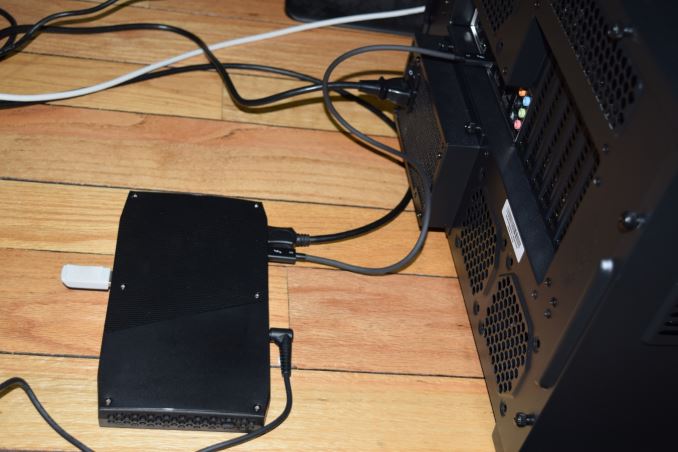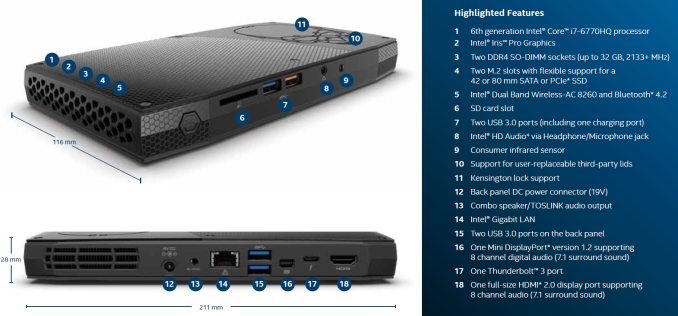The Intel Skull Canyon NUC6i7KYK mini-PC Review
by Ganesh T S on May 23, 2016 8:00 AM ESTMiscellaneous Aspects and Concluding Remarks
One of the more impressive aspects of the Skull Canyon NUC6i7KYK is the reappearance of Thunderbolt in a mini-PC. We have already covered Thunderbolt 3 in good detail. From the perspective of a Skull Canyon evaluation, the Thunderbolt 3 port does deserve a bit of attention. It must be noted that this USB Type-C port can also act as a USB 3.1 Gen 2 host port. Our evaluation of this feature is in two parts - we first hooked up a SanDisk Extreme 900 1.92TB USB 3.1 Gen 2 SSD and ran a quick speed test. We were able to see results similar to our review numbers, indicating that the USB 3.1 Gen 2 mode was indeed active. For the Thunderbolt part, we decided to check out Thunderbolt networking with our direct-attached storage testbed.
A Thunderbolt cable between two PCs is enough to create a Thunderbolt network
Connecting the Thunderbolt ports on the two machines and allowing the PCs to talk to each other automatically creates a 10Gbps network adapter. For a setup with just two machines, it is enough to just set static IPs on the interfaces of both machines in the same subnet, and setting the network location to private so that the machines can talk to each other. We configured a RAM drive on the testbed and mapped it as a network drive on the NUC6i7KYK, Running CrystalDiskMark on the mapped drive showed read speeds of 700 MBps and write speeds of 620 MBps, indicative of a 10Gbps link. The gallery below presents some screenshots of the benchmarks as well as the Thunderbolt networking setup steps.
Moving on to the business end of the review, let us get the complaints out of the way - While the size and form-factor of Skull Canyon are impressive, the acoustic profile is not that great. We would gladly trade a modest increase in the footprint of the system for lower fan noise. That said, the fan noise is in no way comparable to the BRIX Gaming lineup. It is just that it is not as silent as the traditional NUCs.
On the board layout front, we are unable to fathom why the CPU's PCIe lanes are not used at all. It would have been great to have a dual-port Alpine Ridge controller hang directly off the CPU's PCIe lanes. Finally, the ports on the chassis could have done with better spread. The two pairs of USB ports are such that one occupied port ends up making it difficult to utilize the other one in the pair. A port on one of the sides, or, on the lid (without relying on third-party designs), would be very welcome.
But with the above caveats in mind, Skull Canyon is definitely a great product. Simply put, it packs the most punch among systems with similar footprints. It is excellent for casual gamers, but, unfortunately, stops short of being a replacement for systems like the Zotac ZBOX MAGNUS EN970 or the ASRock VisionX 471D - two small form-factor PCs that integrate discrete GPUs at the cost of a larger footprint compared to Skull Canyon. The Thunderbolt 3 port, with an external GPU dock, can somewhat make up for the lack of a discrete GPU for gamers. However, the cost factor becomes a major issue. The 4C/8T configuration of the Core i7-6770HQ is also attractive to consumers looking for a small form-factor system with a powerful CPU, but, they must remember that some price premium is being paid for the Iris Pro graphics.
I am actually looking forward to what vendors like Zotac and ASRock can do with a similar design. If they could take a Skylake-H processor without Iris Pro (say, Core i7-6820HQ), and use the PCIe lanes off the CPU to hook up a mobile discrete GPU, it could deliver the best of both worlds - all the 45W TDP of the CPU can be used to provide raw processing power for CPU-intensive workloads, while a dGPU can handle graphics duties with a separate power budget.
To summarize, Intel has indeed managed to change the game with the NUC6i7KYK. A look at the increase in the gaming capabilities over the previous generation 'gaming' NUCs make the Skull Canyon updates to appear evolutionary in nature. However, the overall platform capabilities (including a much more powerful -H series CPU instead of a -U series CPU, as well as the integration of Thunderbolt 3 and dual M.2 PCIe 3.0 x4 SSD slots) are enough to justify the price premium ($650 for the barebones configuration).


















133 Comments
View All Comments
KurtKrampmeier - Tuesday, May 24, 2016 - link
Can Undervolting achieve significantly better thermals and less cpu throttling? And if so, by how much? I want to use this as a 24/7 load and very small and light portable cpu package. Thank you!Drazick - Tuesday, May 24, 2016 - link
Ganesh, When will we have high TDP (65W and above) CPU with Iris Pro?I would even go farther, I'd like to see Extreme Edition CPU's with Iris Pro.
I hope Core I7 7820K will also have a configuration with Iris Pro and 128MB of eDRAM.
It's time Intel to bring Iris Pro to the high end desktop chips.
sharath.naik - Wednesday, May 25, 2016 - link
Not sure about the price. At this price isnt it just better to buy a Laptop with discrete graphics and remove the display if you donot want it?Eva Green - Thursday, May 26, 2016 - link
The PC provides cutting edge hardware to run the best games ->http://www.gamernode.com/the-pc-power-and-money-in...
cm2187 - Saturday, May 28, 2016 - link
Just received mine. It is quite noisy, even when idle.Madpacket - Monday, May 30, 2016 - link
Neat computer but niche. I'll wait for the fire sale on this one. I could see uses as a dev / portable VM box with the m.2 PCI ports (raid striped). As a gaming machine this thing is about as useful as a A10-7870K or even less for driver reasons. But at least it can do some low end gaming however you would be much better off with an Alienware Alpha which is still tiny and packs a real GPU and is about half the price.gue2212 - Saturday, June 4, 2016 - link
"Connecting the Thunderbolt ports on the two machines and allowing the PCs to talk to each other automatically creates a 10Gbps network adapter."Can anyone shed some light: When TB3 can transfer 40Gbps (bundle the 4 PCIe 3 lanes), why do we end up with 10Gbps USB 3.1 Gen2 speed for networking?
Well, woulda been too good at 40, but I guess I´ll abuse the NUC6i7KYK as an external storage (partition backup) for my Dell XPS 9550 until I see a TB3 SSD with the Samsung T3 SSD form-factor. ;-)
mystikmedia - Thursday, June 9, 2016 - link
I have this NUC. I am very happy with it overall. I can't seem to get the Thunderbolt port to work, though. I bought a USB 3.0 hub that has a Type C connection. I figured I might as well put that Type C port to use and not waste an existing USB port. But, it doesn't seem to work. Should it? I had assumed the USB 3.1 aspect of it would be backwards compatible with 3.0, as has been the case in the past. Is that incorrect? TIAgue2212 - Saturday, June 18, 2016 - link
Hey mysticmedia,I don´t understand what you´re trying to accomplish. You got 4 USB 3.0 ports on the NUC6i7KYK. Why in heaven would you hook up a USB 3.0 hub to the TB 3?
gue2212 - Sunday, June 19, 2016 - link
How are the connectors / headers supposed to be used (left back cut-out in the metal under the top plastic cover)?According to the circuit schema they are internal USB 3 and 2, NFC and LPC Debug.